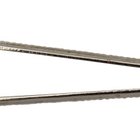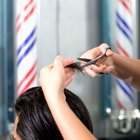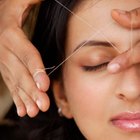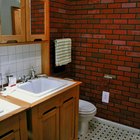
Electrolysis is the only form of permanent hair removal, and it's also possible to do this at home with the right equipment. However, keep in mind that in the hands of the unskilled, home electrolysis can be extremely painful and take a longer time than it would have had you sought the services of a professional. If you choose to pursue at-home electrolysis, take safety precautions to reduce your risk of scars and infected skin.
How Electrolysis Works
During the process of electrolysis, a fine needle or probe is slipped through the skin alongside the hair follicle next to the root. A short current of electricity is delivered through the end of the wire to the root, effectively rendering it incapable of regrowth. The dead hair is then tweezed out. According to the FDA, risks associated with electrolysis are infection from using unsanitary equipment and scarring due to poor technique. Because electrolysis tackles hair growth one follicle at a time, it can be very time-consuming, even when performed by a professional electrologist. Home electrolysis takes even longer.
Home Electrolysis
According to skincare expert Paula Begoun, home electrolysis devices work the same way as the machines used by professional electrologists. However, they use a much lower voltage, reducing their efficacy. According to Begoun, "The chances of operating these devices successfully are at best slim. You would probably end up just tweezing instead of zapping the hair because getting the device to work right is extremely tricky." With home electrolysis, you increase your risk of infection and scarring, especially if you aren't diligent about taking safety precautions or if you lack the skill to insert the tiny probe correctly.
Other Downsides
At-home electrolysis appears to have many advantages; once you purchase your device, there's no need to spend any more money. Also, you can use your home electrolysis device on your own time-table in the convenience of your own home. However, Andrea James of HairFacts.Com, points out that there are more disadvantages to home electrolysis than advantages, and does not recommend you pursue this method of hair removal. It takes much longer to treat each follicle, so you must be dedicate a large amount of time to self-treatment. The side effects of home electrolysis–redness and swelling of the skin–are reportedly worse than those associated with professional treatment. If you must use your non-dominant hand to treat yourself, this may be extremely cumbersome, if not impossible. The bottom line is that the more hair you want to get rid of, the less success you can expect from home electrolysis, James says.
Safe Home Electrolysis
If you pursue home electrolysis, make sure that you work in a clean workspace, James advises. Start with clean hands and skin and disinfect the probe on your home device with rubbing alcohol. Work in a well-lighted area and use mirrors to work on parts of the skin you can't see. Treat small patches of skin at a time, and give yourself two days for your skin to recover so you can make sure you respond favorably to home treatment. Avoid treating the hair on your face; because you must use an inverse hand direction, home electrolysis is extremely difficult--and dangerous--to perform on this part of your body. James also recommends watching a professional electrologist to learn appropriate techniques.
Other Tips
Some home gadgets may masquerade as electrolysis devices when they really aren't. Electric tweezers–those that use forceps to grasp the hair and deliver an electric current through the hair to the root–are ineffective, says Begoun. The FDA agrees, stating, "There is no body of significant information establishing the effectiveness of the tweezer epilator to permanently remove hair." Finally, keep in mind that electrology is a learned skill that's very difficult to perform effectively on your own; according to the American Electrology Association, 33 states have licensing or certification standards in place that require professional electrologists to have a certain number of hours of experience, as well as ongoing continuing education requirements.
Related Articles

Homemade Electrolysis for Hair Removal

How to Stop Facial Hair Growth for Men

What Are the Dangers of Electrolysis ...

How to Remove Hair Follicles to Prevent ...

Home Remedies to Permanently Remove ...

How to Stop Hair Growth on Your Fingers

What Is a Good Way to Get Rid of Hair ...

How to Taper Sideburns

How to Troubleshoot the Oster Clippers

Ways of Removing Hair From Nipple

Side Effects of Veet Waxing Strips

Shaving Bumps After Using Epilator

How to Treat an Ingrown Eyebrow Hair

How to Take Care of Painful Ingrown Hair

Microdermabrasion for the Neck

Disadvantages to Eyebrow Threading

What Is Skin Polishing?

How Long Does Tweezing Last?

How to Remove Hairs From Moles

Handicapped Bathroom Grants for Veterans
References
Resources
Writer Bio
Lisa Sefcik has been writing professionally since 1987. Her subject matter includes pet care, travel, consumer reviews, classical music and entertainment. She's worked as a policy analyst, news reporter and freelance writer/columnist for Cox Publications and numerous national print publications. Sefcik holds a paralegal certification as well as degrees in journalism and piano performance from the University of Texas at Austin.
Photo Credits
legs image by Leticia Wilson from Fotolia.com